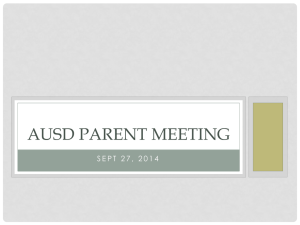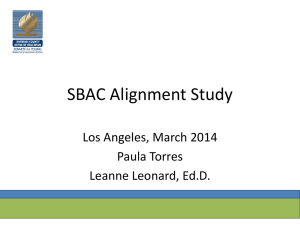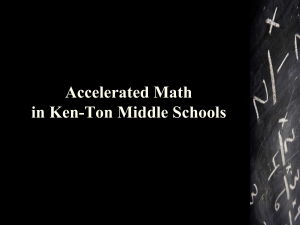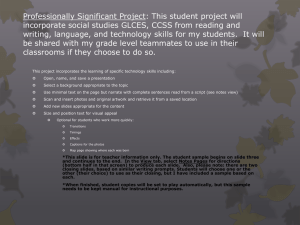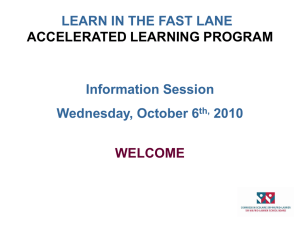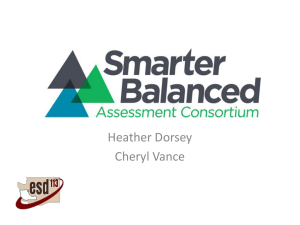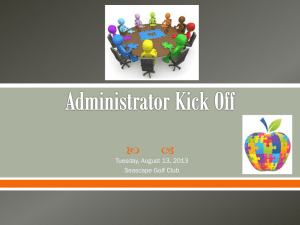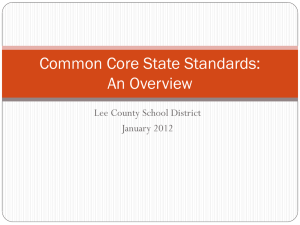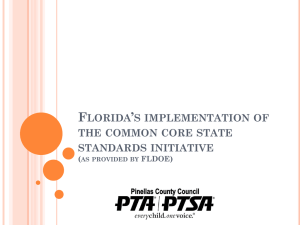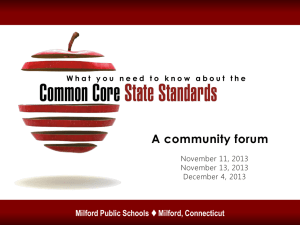09-27_ Parent Summit_ CCSS Math
advertisement
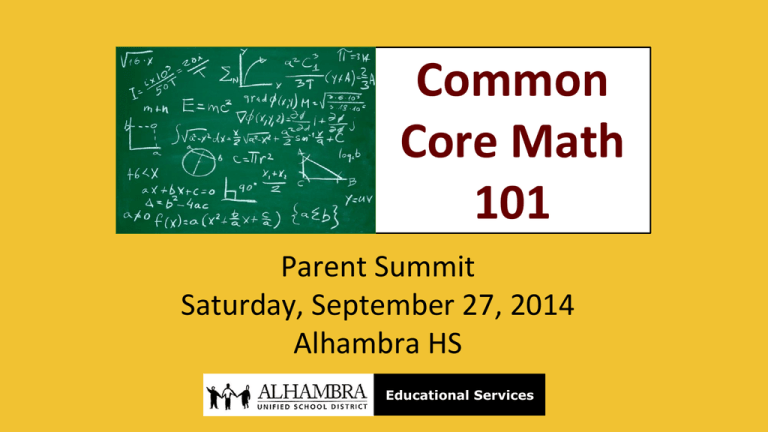
Common Core Math 101 Parent Summit Saturday, September 27, 2014 Alhambra HS Educational Services CCSS Shifts in Math ● Focus - we cover fewer topics in greater depth. We aren’t just teaching kids to do math that a calculator already performs. We are teaching them to apply it and make sense of the calculation. ● Coherence - each year of Integrated Math builds on the previous years instead of skipping from Algebra to Geometry back to Algebra 2, etc... ● Rigor - equal time spent on conceptual understanding, procedural fluency, and real-world application in the classroom Are we there yet? Pop Quiz! How far apart are the Jct 90 and Jefferson Blvd exits on the 405 North? Procedures are not Enough How far apart are these two exits? Student doesn’t understand the wording and adds insteads of subtracts Same student can solve the corresponding subtraction problem, but not the real world problem! Courtesy Robert Kaplinsky Why Integrated Math? Traditional Math ● Algebra 1 Reg ● Geometry Reg/Honors ● Algebra 2 Reg/Honors ● Trig/Precal Reg/Honors Each year in the sequence requires 6+ weeks of reteaching/review because content is not continuous. Integrated Math ● Integrated/Accelerated Math 1 ● Integrated/Accelerated Math 2 ● Integrated/Accelerated Math 3 Each year in the sequence develops the domains of Functions, Algebra, Numbers, Geometry and Statistics with gradual depth and complexity. College and Career Ready Electives (4th year) ● ● ● ● Trig/Precalc AP Statistics Elementary Calculus AP Calculus AB/BC College and Careers 2013 Survey by Hart Associates asked US employers: “What skills are most valuable in future employees? What skills should be emphasized in a high school education?” Survey says…. Teach the Skills Employers Want Standards of Math Practice ● Make sense of problems and persevere in solving them ● Reason abstractly and quantitatively ● Construct viable arguments and critique the reasoning of others ● Model with mathematics ● Use appropriate tools strategically and attend to precision ● Look for and make use of structure and express regularity Integrated Math and the UC ● The UC A-G Math requirement (“C”) emphasizes Math Content Standards and Standards of Math Practice [LINK] ● UC Statement gives 3 years of Integrated Math equal weight as 3 years of Traditional Math for Freshmen Admission [LINK] ● UC has a FAQ page about their “C” requirement for Math [LINK] if you would like more info ● Our Math 1 and Accelerated Math 1 courses are UC approved for the “C” requirement of A-G as of 8/2014 High School Pathways M1 Extension Math 1 Freshmen Placement -8th Gd Math grades -8th Gd T3 benchmark -CST/SBAC scores M2 Extension Math 2 Moving up to Accelerated any year may require Summer Bridge Accel Math 1 Accel Math 2 Math 3 Trig/Precalc AP Stats Elem. Calc AP Calc AB Moving down to Regular during any year Accel Math 3 AP Stats AP Calc AB AP Calc BC AUSD practices open enrollment in AP/Honors/Accelerated courses at the High School Level Computer Adaptive Testing (CAT) ● ● ● ● ● CST testing has been replaced by SBAC testing, starting with Juniors in Spring 2015 Test is summative and only for 11th graders (Math, ELA) Test is entirely administered on a computer at school Test questions vary in difficulty according to student progress, affects score Test consists of o Selected Response (SR) = multiple choice(s) o Constructed Response (CR) = short answer, fill in the blank, short sentence(s) o Performance Task (PT) = multi-step, real-world problem requiring multiple skills and paragraph explanations Curriculum + Instruction ● ● ● ● ● ● We are using Carnegie Learning’s textbook in both Integrated/Accelerated Math 1 Emphasis is on student-centered learning, with more inquiry and collaborative groups Carnegie Cognitive Tutor software is meant to model the SBAC assessment experience while reinforcing learning Math Textbooks are consumable so students may write on them Students have online access to textbooks should they lose any pages or need to redo a page Students go to computer lab 2 days out of the week to reinforce skills Home Learning ● Home learning reviews prior knowledge and reinforces the current lesson ● Home learning may include reading, note taking, practice problems, or a project ● Home learning assignments are often available in both print and online formats ● Home learning *always* includes reading/review today’s lesson and working ahead, prepping questions for the teacher Support Student Learning ● Check the Family Portal, family.ausd.us on a regular basis ● Ask your child what they learned at school today ● Make sure your child has a quiet, distraction-free setting to study, do homework ● Check on your child while they work on Carnegie software because they may wander to other websites ● Make sure your child takes advantage of free tutoring at school ● Email the teacher with any questions or concerns early on, don’t wait til report cards come out! Educational Resources ● On-campus tutoring at sites during/after school ● Carnegie Resource Center access to textbook, assignments, and skills practice at home ● Carnegie Cognitive Tutor software allows students to practice and master skills at home ● Khan Academy - online tool for studying at home ● Shmoop.com - We Speak Student! Guide to CCSS More Resources ● ● ● ● ● ● ● ● ● ● New SAT (Spring 2016) will align to CCSS [LINK] CCSS Standards [Math 1/Math 2/Math 3] Standards of Math Practice [Eng/Span/Chi] Common Core Standards Institute [Math] CA Dept of Education SBAC Practice Test SBAC Sample Items Online Graphing Calculator Meta Calculator and SBAC Calculator AUSD CCSS Guide Questions, comments or concerns? ● e-mail: bourbois_abelardo@ausd.us walsh_brad@ausd.us ● phone: 626.943.3520 ● web: ccss.ausd.us
